
Much has been written about the Budweiser "macro-beer" commercial. Most of it concerned whether the use of craft beer as a foil, and the portrayal of facial-hair-adorned craft-beer drinkers as fussy, taste-analyzing dweebs was fair/mean/undeserved/likely to backfire, etc.
What's received virtually no attention is the structure and content of the Budweiser commercial. But therein lies its true beauty; the reason it's such an effective ad. So, let's set the whining of craft-beer types aside, and become students of why this commercial works so well.
Simply put, this is an ad that absolutely nails four keys to creating solid, effective beer-selling messages.
 Is this you? If not, Budweiser wants a word with you.
Is this you? If not, Budweiser wants a word with you. The whine-volume from the craft-beer crowd actually demonstrates how effectively Budweiser targeted its message.
People purchase any brand because they perceive it will deliver them a benefit. So, in evaluating ads, it's worth asking "What's the benefit being offered here?" The more anchored it is in a perceivable, beer-drinking-experience difference, the more powerful the benefit will be. So, if you choose Budweiser, the promised benefit is an in-mouth experience. Expect a crisp finish with none of the aftertaste so very common in virtually all craft beer.
 The reason-why
The reason-why  "One and only"... as in "unique."
"One and only"... as in "unique." A telling--but unintended-- example of how effective advertising can be when it delivers on these four keys came by way of a quickly assembled online parody of Budweiser's commercial. It was intended to turn the tables, but instead serves to underscore the effectiveness of the big brewer's advertising approach.
Of course, as a parody, it apes the style of the original. But watch and see how it (1) addresses its target, (2) states a benefit, (3) provides reason(s)-why, and (4) communicates uniqueness...
Class dismissed.








 RSS Feed
RSS Feed
